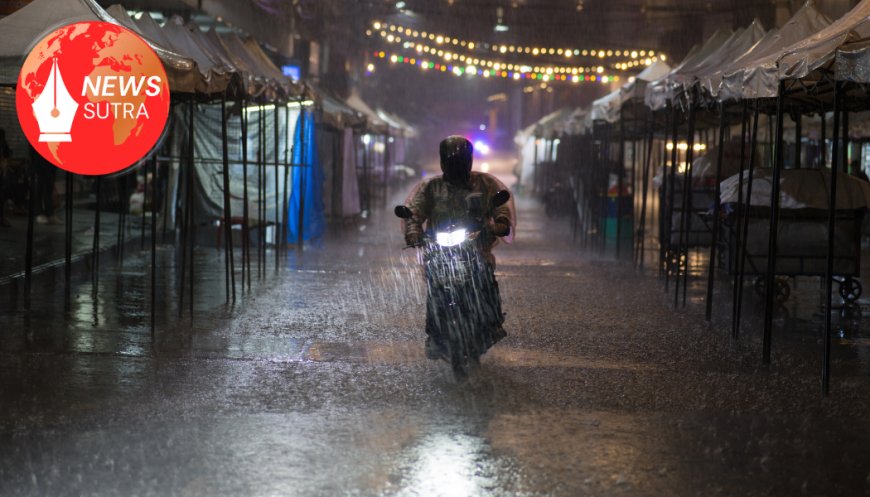Monsoon on Hold: IMD Forecasts Delay in Rains Across India—Here’s What to Expect
The India Meteorological Department (IMD) has confirmed a delay in the monsoon’s arrival. Read the latest forecast, regional impact, agricultural concerns, and expert advice in this detailed weather update.

In a concerning turn for millions dependent on seasonal rains, the India Meteorological Department (IMD) has officially announced a delay in the arrival of the southwest monsoon. Originally expected to reach the southern coast by June 1, the monsoon has now been postponed by approximately a week, and experts are warning of possible downstream impacts across the country.
The delay has sparked worries in sectors ranging from agriculture and water management to power generation and public health.
IMD’s Official Statement on Monsoon Progress
According to the latest IMD bulletin, the southwest monsoon's onset over Kerala is likely to be delayed until June 7 or later. Meteorologists attribute this delay to weakened cross-equatorial winds, cooler sea surface temperatures over the Indian Ocean, and the lingering effects of El Niño conditions.
Dr. Mrutyunjay Mohapatra, Director General of Meteorology at IMD, stated, “We are observing a slower development of the monsoon circulation this year, which may also influence its northward progression.”
What This Delay Means for the Country
India’s monsoon is more than a weather phenomenon—it’s a lifeline for over 50% of the population, especially farmers who rely on timely rains for kharif crop sowing.
1. Agriculture: A Looming Concern
A monsoon delay directly affects sowing of major crops like rice, cotton, pulses, and maize. If rains arrive late, farmers may have to shift crop choices or delay sowing, leading to reduced yields and potential supply chain disruptions.
For a detailed analysis, refer to the Indian Council of Agricultural Research (ICAR) resources on adaptive farming practices.
2. Reservoir and Water Management
The Central Water Commission (CWC) has already issued a note of caution regarding low storage levels in several major reservoirs, including those in Maharashtra, Tamil Nadu, and Karnataka. Without timely rainfall, water stress will increase across urban and rural belts alike.
Explore real-time updates on reservoir levels at the CWC Hydrology Portal.
3. Power and Energy Sector
With hydropower generation dependent on water inflows, the delay could put additional pressure on thermal power stations and lead to power shortages or increased tariffs, especially in already heat-struck northern states like Punjab and Rajasthan.
Regional Forecasts: What to Expect Where
Here’s a breakdown of the IMD’s region-specific forecast:
-
South India: Kerala and coastal Karnataka will experience below-normal rainfall in the first two weeks of June.
-
Central India: States like Madhya Pradesh and Chhattisgarh may see a delayed monsoon onset by 5–7 days, with possible deficit conditions.
-
Northwest India: The monsoon’s reach into Delhi, Haryana, and western Uttar Pradesh could be pushed to the first week of July, subject to changing wind patterns.
-
Northeast India: While rainfall has been erratic, the region may see localized heavy downpours due to pre-monsoon disturbances.
For localized forecasts, follow Skymet Weather’s updates.
Why the Delay? A Look at Climate Indicators
Several climatic variables are contributing to this year’s sluggish start:
-
El Niño–Southern Oscillation (ENSO): Persisting warm ocean temperatures in the Pacific are known to suppress monsoon strength.
-
Indian Ocean Dipole (IOD): Currently in a neutral phase, offering little support to offset El Niño effects.
-
Madden-Julian Oscillation (MJO): An active MJO could still aid monsoon revival later in June, but current models show limited activity.
You can learn more about these factors in detail through the NOAA Climate Prediction Center.
Expert Advice for Farmers and Policy Makers
Given the uncertainty, agricultural scientists and planners are recommending:
-
Staggered sowing of kharif crops
-
Use of drought-resistant crop varieties
-
Increased irrigation efficiency, particularly in semi-arid zones
-
Coordination with Krishi Vigyan Kendras (KVKs) for localized support
The Ministry of Agriculture and Farmers Welfare has also issued advisories encouraging adaptive planning to mitigate economic losses.
Urban Impact: Heat, Water Shortages, and Air Quality
With delayed rains, urban heat islands like Delhi and Mumbai are witnessing extreme heatwaves, prolonged dry spells, and deteriorating air quality. Public health officials have warned of increased cases of heatstroke, dehydration, and water-borne diseases.
Hospitals across cities have been asked to remain vigilant, especially in slum areas and high-density zones. For a public health guide on extreme heat, refer to MedlinePlus Heat Safety.
Hope on the Horizon?
While the start has been delayed, IMD forecasts suggest that the monsoon may pick up pace in the latter half of June. The department remains cautiously optimistic that cumulative rainfall between June and September will remain “near-normal”, depending on oceanic and atmospheric conditions evolving in the coming weeks.
Final Takeaway
The delay in monsoon is a stark reminder of the growing unpredictability of climate systems. While short-term adaptation is essential, it also underscores the urgent need for long-term climate resilience strategies. From agriculture to urban planning, India must now plan not just for rains—but also for their absence.














